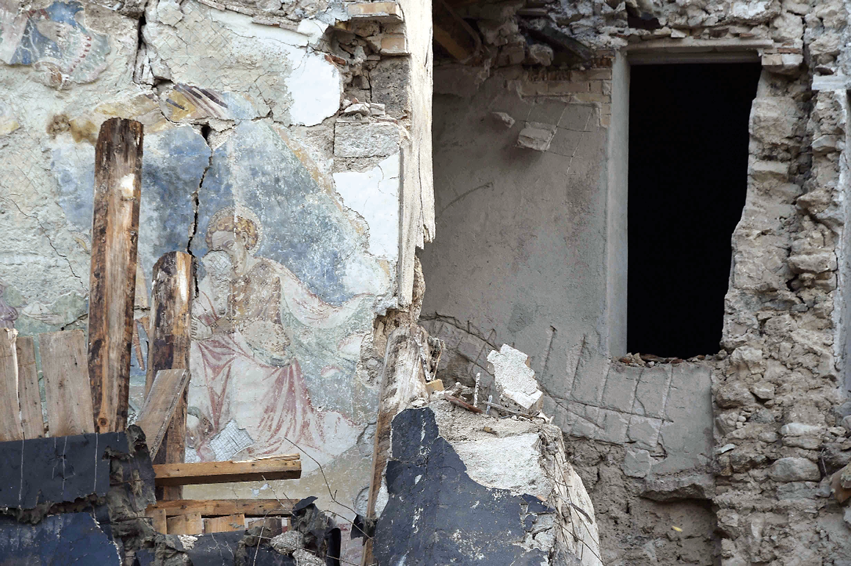by Tomaso Montanari
Andrea De Marchi – the art historian who, probably more than any other art historian, has spent much time and energy informing the Italian people about the size and the range of the earthquake that opened up a crater in the heart of central Italy last year – has recently reminded us that, “along the course of the River Potenza, a little before Pioraco, near a pleasant stream, a little wood conceals the Oratory of the Holy Crucifix at Ponte Cannaro, a fragmented hint of that verdant nature that so enchanted that marchioness from Mantua, Isabella d’Este, on one Spring day in 1494, when she was staying with Giulio Cesare da Varano at Pioraco. She described the spot as being a “a little park full of wild animals, between two high hills and a little lake with two little islands in the middle, ideal for any sort of recreation. If you do not see it you will not be able to believe that between two such hills nature could have produced something so pleasant.’” (quoted from the special issue of the magazine “Predella” that had been dedicated to the earthquake).
How many Italians have been to this (still) enchanted place? That marvellous letter by Isabella said so explicitly what, in times closer to us, Federico Zeri tried to say an endless amount of times, that the beauty in so-called “lesser” parts of Italy cannot merely be told or only seen, “if you do not see them, you’ll never believe they exist”! The first thing that has to be done, therefore, is to show this land to the Italians themselves so that it becomes clear to everyone how many and which of the values most dear to us need to be protected.
The second thing that needs to be done is to teach all of this to those who are governing us. Let us take as an example the latest allocation of funds for our cultural heritage, that famous billion euro granted to us by the Renzi government on May 1st 2016. Above all else, as a matter of fact, this “allocation” was actually a one-off ‘gift’, quite the opposite of the continuous flow of ordinary funds that are required to keep up everyday maintenance. 850 million of this was actually destined for the “larger tourist attractions” and only the remaining 150 million would be shared out among the ‘lesser’ monuments and sites and then according to a sort of a hit parade decided by the public – like in a TV contest – who were encouraged to send in their votes to the incredible-sounding email address of bellezza@governo.it.
All of this helps us understand why, even to a much lesser degree, the cultural rescue machine did not start off in the swiftest of ways. For the first time since the unification of Italy we were not even able to remove from unstable churches any (removable) works of art.
Umbria and its cultural heritage owe very much to the scholar, Bruno Toscano, who has recently sadly declared that “so very little, almost nothing”, was done and that “I am convinced that San Salvatore in Campi could have been saved since it was a small building and did not require any particularly burdensome forms of intervention. It was by no means Spoleto Cathedral! This is just one episode of what has not been done, one of many such episodes, unfortunately. Episodes which, in my opinion, are highly serious omissions made by democratically appointed local administrations”.
This is a situation that has been explained in some considerable depth by Salvatore Settis. “Why wasn’t the reaction to the 2016 earthquake in proportion to the vastness and depth of the problem? The sad answer is that the institutions that are appointed to protect our cultural heritage – the soprintendenze or cultural authorities – have been considerably weakened by the twenty-year long reduction in financial and human resources as well as the Franceschini reform which is reducing resources to a shadow of their former selves. Such “holistic” neo-authorities are mixing up without any sense or reason the cards that are currently on the table. They are moving employees around, drastically cutting down on staff who were previously dedicated to the protection of the local environment and thus making any archive research even more difficult on account of this continuous moving around. The few – indeed often “heroic” – employees left have often exposed themselves to the prime minister Renzi’s tirades against these very cultural representatives: “Cultural representative or sovrintendente is one of the ugliest words in the entire vocabulary of bureaucracy, one of the those grey-sounding words. It mangles enthusiasm and imagination from the third syllable when uttered. Representative of what?”
Those venturing into the field of culture are even tougher. A few days ago, De Marchi himself wrote to me, incredibly upset after having walked at length through the ruins at Camerino. He witnessed how our cultural heritage has been abandoned by a “Ministry that is dramatically devoid of means and people. Apart from the facile propaganda surrounding the event and the reassuring stories enveloping the tragedy it is the actual collapsing of the buildings, one after the other, which has told a very different story”. The people who have stayed behind at Amatrice have sent the Minister, Franceschini, a heartrending and exceptionally tough letter, obviously ignored by the newspapers that are fuelling the story of the reconstruction: “But, do you, Mr Minister, fully understand the situation in which we are living? Do you realise that, along with the monuments and sites of Amatrice, we are losing, as Italian citizens, a piece of our history. We are losing a piece of Italy since our country has never undertaken – except on the most minimal of scales – those very actions that would have saved at least a part of our cultural heritage?”
Without a shadow of doubt, the Minister does not realise this. But do we?

